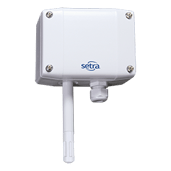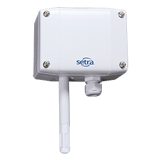Relative humidity (%RH) is a measurement of how much water vapor is in the air compared to how much water vapor could be in the air. Monitoring relative humidity is important in a variety of environments, from office spaces to operating rooms to industrial manufacturing.
What is relative humidity?
Relative humidity can either help or hinder an environment from operating properly. Too high of a humidity can shorten the shelf life of medications or encourage the growth of viruses, bacteria, and other common irritants such as mold. Too low of a humidity inflames the mucous membranes, thus irritating the nose and the throat. By monitoring relative humidity, the occupants of an environment can make any necessary adjustments to maintain the proper %RH.
In an office space, monitoring humidity can help prevent sick building syndrome, which results in acute health and comfort issues from spending lots of time in a building environment. Monitoring humidity is critical in environments other than offices, including cleanrooms, operating rooms, patient isolation rooms, pharmaceutical labs, industrial manufacturing, and compounding pharmacies. In these environments, the wrong humidity can have severe consequences.
Setra has a solution
 Setra's new Humidity product line, on display at AHR 2019, is designed to continuously monitor the relative humidity and temperature in critical environments. The humidity product line is compatible with both BACnet and Modbus. Versatile to be either duct or wall mounted with remote sensing an option for some models, the humidity product line can be adapted to many different environments.
Setra's new Humidity product line, on display at AHR 2019, is designed to continuously monitor the relative humidity and temperature in critical environments. The humidity product line is compatible with both BACnet and Modbus. Versatile to be either duct or wall mounted with remote sensing an option for some models, the humidity product line can be adapted to many different environments.
With quarter-turn bayonet screws and easily accessible electrical connections, humidity monitor install is simple. The faceplate of the sensors provides great protection against both contaminates and condensation. And with this protection, the faceplate provides stability for the sensor even in aggressive or polluted environments.
Accuracy matters
Accuracy plays an important role in monitoring relative humidity in critical environments. The less accurate a sensor, the higher the risk of the %RH negatively impacting an environment. To combat the potential inaccuracy of sensors, Setra accounts for non-linearity, hysteresis, and repeatability in the accuracy of our products.



